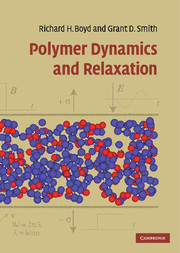Book contents
- Frontmatter
- Contents
- Preface
- Part I Methodology
- Part II Amorphous polymers
- 6 The primary transition region
- 7 Secondary (subglass) relaxations
- 8 The transition from melt to glass and its molecular basis
- Part III Complex systems
- Appendix AI The Rouse model
- Appendix AII Site models for localized relaxation
- Index
- References
8 - The transition from melt to glass and its molecular basis
Published online by Cambridge University Press: 10 November 2009
- Frontmatter
- Contents
- Preface
- Part I Methodology
- Part II Amorphous polymers
- 6 The primary transition region
- 7 Secondary (subglass) relaxations
- 8 The transition from melt to glass and its molecular basis
- Part III Complex systems
- Appendix AI The Rouse model
- Appendix AII Site models for localized relaxation
- Index
- References
Summary
Experimental description
The preceding chapters of Part II have dealt with the primary relaxation that takes place in the melt and secondary subglass relaxations at lower temperature. However, it is a matter of experimental observation that the time or frequency locations of these relaxations tend to merge as temperature increases or conversely to diverge as temperature is lowered. This is implied in loss maps such as Figure 7.13 where extrapolation to higher temperature, as illustrated in Figure 8.1, indicates the secondary and primary relaxations merge. In fact the extrapolations based on the centers of the processes seem to converge in the region of ∼1011–1012 Hz or on the time scale of picoseconds. This would seem to be inevitable since the time scale of slower intramolecular vibratory and torsional oscillations is of this order and motions related to more elaborate conformational transitions could not be faster than these limits. Since the relaxations are broad, the merging region is expected to be noticeable experimentally in loss vs. frequency curves at temperatures well below this implied high frequency limit. In fact this is the case.
Examples of the overlap and coalescence behavior from dielectric spectroscopy
It is useful to recognize several stages in the merging. The first is an overlap region where maxima in the loss processes for both relaxations are clearly visible.
- Type
- Chapter
- Information
- Polymer Dynamics and Relaxation , pp. 142 - 196Publisher: Cambridge University PressPrint publication year: 2007

